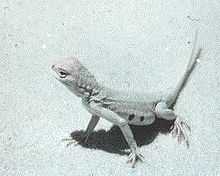Holbrookia
| Holbrookia | |
|---|---|
 | |
| Scientific classification | |
| Kingdom: | Animalia |
| Phylum: | Chordata |
| Subphylum: | Vertebrata |
| Class: | Reptilia |
| Order: | Squamata |
| Suborder: | Lacertilia |
| Family: | Phrynosomatidae |
| Genus: | Holbrookia Girard, 1851 |
Holbrookia is a genus of earless lizards, known commonly as the lesser earless lizards, which contains three recognized species found throughout the southwestern and central United States and northern Mexico. They are characterized by having no external ear openings, presumably to prevent sand from entering their bodies when they are digging. The name Holbrookia is in honor of American zoologist, John Edwards Holbrook.
Description
Lesser earless lizards grow to approximately 2.0-2.5 inches (50-65 mm) snout-to-vent length, plus a tail 3-4 inches (75-100 mm) long. They are typically grey or tan in color, with black blotching. The males usually have blue patches on either side of their bellies, whereas the females do not. Females will often change to have bright orange patches when gravid.
Behavior
Holbrookia species are diurnal, basking lizards. They spend the vast majority of their time sunning on rocks, even in the heat of the day, until the surface temperature reaches approximately 104°F, when they will retreat to a rock crevice or burrow. They are insectivorous.
Species
- Spot-tailed earless lizard, H. lacerata Cope, 1880
- Lesser earless lizard, H. maculata Girard, 1851
- Keeled earless lizard, H. propinqua Baird & Girard, 1852
Geographic range
Earless lizards are found in the southwestern and central United States, in the states of Texas, Arizona, New Mexico, Utah, Colorado, Kansas, Oklahoma, and as far north as Nebraska, South Dakota, and Wyoming. They are also found in Mexico, in the states of Sonora, Chihuahua, Coahuila, Sinaloa, Durango, Zacatecas, San Luis Potosí, Nuevo León, Tamaulipas and Veracruz.
See also
- Genus Cophosaurus, the Greater Earless Lizards.